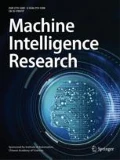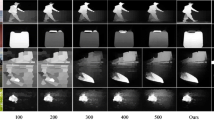Abstract
The graph-based manifold ranking saliency detection only relies on the boundary background to extract foreground seeds, resulting in a poor saliency detection result, so a method that obtains robust foreground for manifold ranking is proposed in this paper. First, boundary connectivity is used to select the boundary background for manifold ranking to get a preliminary saliency map, and a foreground region is acquired by a binary segmentation of the map. Second, the feature points of the original image and the filtered image are obtained by using color boosting Harris corners to generate two different convex hulls. Calculating the intersection of these two convex hulls, a final convex hull is found. Finally, the foreground region and the final convex hull are combined to extract robust foreground seeds for manifold ranking and getting final saliency map. Experimental results on two public image datasets show that the proposed method gains improved performance compared with some other classic methods in three evaluation indicators: precision-recall curve, F-measure and mean absolute error.
Similar content being viewed by others
References
S. Goferman, L. Zelnik-Manor, A. Tal. Context-aware saliency detection. IEEE Transactions on Pattern Analysis and Machine Intelligence, vol. 34, no. 10, pp. 1915–1926, 2012. DOI: https://doi.org/10.1109/TPAMI.2011.272.
C. X. Guo, Z. B. Li, X. Qiao, C. Li, J. Yue. Image segmentation of underwater sea cucumber using GrabCut with saliency map. Transactions of the Chinese Society for Agricultural Machinery, vol. 46, no. S1, pp. 147–152, 2015. (in Chinese)
X. F. Wang, C. Qi. An action recognition method using saliency detection. Journal of Xi’an Jiaotong University, vol. 52, no. 2, pp. 24–29, 44, 2018. DOI: https://doi.org/10.7652/xjtuxb201802004. (in Chinese)
P. F. Yue, H. Y. Wang, Y. J. Zheng, Y. H. Zhao, J. Cui. Image retargeting using blur based depth saliency descriptor. Journal of Computer-Aided Design & Computer Graphics, vol. 30, no. 3, pp. 415–423, 2018. DOI: https://doi.org/10.3724/SP.J.1089.2018.16405. (in Chinese)
J. Sun, P. Wang, Y. K. Luo, G. M. Hao, H. Qiao. Precision work-piece detection and measurement combining top-down and bottom-up saliency. International Journal of Automation and Computing, vol. 15, no. 4, pp. 417–430, 2018. DOI: https://doi.org/10.1007/s11633-018-1123-1.
J. M. Yang, M. H. Yang. Top-down visual saliency via joint CRF and dictionary learning. In Proceedings of the IEEE International Conference on Computer Vision and Pattern Recognition, IEEE, Providence, USA, pp. 2296–2303, 2012. DOI: https://doi.org/10.1109/CVPR.2012.6247940.
N. Tong, H. C. Lu, X. Ruan, M. H. Yang. Salient object detection via bootstrap learning. In Proceedings of the IEEE International Conference on Computer Vision and Pattern Recognition, IEEE, Boston, USA, pp. 1884–1892, 2015. DOI: https://doi.org/10.1109/CVPR.2015.7298798.
H. Y. Li, H. C. Lu, Z. Lin, X. H. Shen, B. Price. Inner and inter label propagation: Salient object detection in the wild. IEEE Transactions on Image Processing, vol. 24, no. 10, pp. 3176–3186, 2015. DOI: https://doi.org/10.1109/TIP.2015.2440174.
J. Y. Lü, Z. M. Tang. An improved graph-based manifold ranking for salient object detection. Journal of Electronics & Information Technology, vol. 37, no. 11, pp. 2555–2563, 2015. DOI: https://doi.org/10.11999/JEIT150619. (in Chinese)
X. Lin, Y. L. Wang, H. L. Zhu, L. Z. Ma, L. H. Jiang. Saliency detection based on the Bayesian model of improved convex hull. Journal of Computer-Aided Design & Computer Graphics, vol. 29, no. 2, pp. 221–228, 2017. DOI: https://doi.org/10.3969/j.issn.1003-9775.2017.02.002. (in Chinese)
D. M. Liu, F. L. Chang. Coarse-to-fine saliency detection based on non-subsampled contourlet transform enhancement. Acta Optica Sinica, vol. 39, no. 1, Article number 0115003, 2019. DOI: https://doi.org/10.3788/AOS201939.0115003. (in Chinese)
M. M. Cheng, N. J. Mitra, X. L. Huang, P. H. S. Torr, S. M. Hu. Global contrast based salient region detection. IEEE Transactions on Pattern Analysis and Machine Intelligence, vol. 37, no. 3, pp. 569–582, 2015. DOI: https://doi.org/10.1109/TPAMI.2014.2345401.
M. M. Cheng, G. X. Zhang, N. J. Mitra, X. L. Huang, S. M. Hu. Global contrast based salient region detection. In Proceedings of IEEE International Conference on Computer Vision and Pattern Recognition, IEEE, Providence, USA, pp. 409–416, 2011. DOI: https://doi.org/10.1109/CVPR.2011.5995344.
T. Liu, Z. J. Yuan, J. Sun, J. D. Wang, N. N. Zheng, X. O. Tang, H. Y. Shum. Learning to detect a salient object. IEEE Transactions on Pattern Analysis and Machine Intelligence, vol. 33, no. 2, pp. 353–367, 2011. DOI: https://doi.org/10.1109/TPAMI.2010.70.
Y. C. Wei, F. Wen, W. J. Zhu, J. Sun. Geodesic saliency using background priors. In Proceedings of the 12th European Conference on Computer Vision, Springer, Florence, Italy, pp. 29–42, 2012. DOI: https://doi.org/10.1007/978-3-642-33712-3_3.
W. J. Zhu, S. Liang, Y. C. Wei, J. Sun. Saliency optimization from robust background detection. In Proceedings of IEEE International Conference on Computer Vision and Pattern Recognition, IEEE, Columbus, USA, pp. 2814–2821, 2014. DOI: https://doi.org/10.1109/CVPR.2014.360.
C. Yang, L. H. Zhang, H. C. Lu, X. Ruan, M. H. Yang. Saliency detection via graph-based manifold ranking. In Proceedings of the IEEE International Conference on Computer Vision and Pattern Recognition, IEEE, Portland, USA, pp. 3166–3173, 2013. DOI: https://doi.org/10.1109/CVPR.2013.407.
Y. L. Xie, H. C. Lu. Visual saliency detection based on Bayesian model. In Proceedings of the 18th IEEE International Conference on Image Processing, IEEE, Brussels, Belgium, pp. 645–648, 2011. DOI: https://doi.org/10.1109/ICIP.2011.6116634.
R. S. Liu, J. J. Cao, Z. C. Lin, S. G. Shan. Adaptive partial differential equation learning for visual saliency detection. In Proceedings of IEEE International Conference on Computer Vision and Pattern Recognition, IEEE, Columbus, USA, pp. 3866–3873, 2014. DOI: https://doi.org/10.1109/CVPR.2014.494.
C. Wang, Y. Y. Fan, B. Li. Saliency detection based on robust foreground selection. Journal of Electronics & Information Technology, vol. 39, no. 11, pp. 2644–2651, 2017. DOI: https://doi.org/10.11999/JEIT170390. (in Chinese)
H. H. Yeh, C. S. Chen. From rareness to compactness: Contrast-aware image saliency detection. In Proceedings of the 19th IEEE International Conference on Image Processing, IEEE, Orlando, USA, pp. 1077–1080, 2012. DOI: https://doi.org/10.1109/ICIP.2012.6467050.
Q. Yan, L. Xu, J. P. Shi, J. Y. Jia. Hierarchical saliency detection. In Proceedings of IEEE International Conference on Computer Vision and Pattern Recognition, IEEE, Portland, USA, pp. 1155–1162, 2013. DOI: https://doi.org/10.1109/CVPR.2013.153.
Z. J. Yao, T. Z. Tan. Saliency detection combining background and foreground prior. Journal of Image and Graphics, vol. 22, no. 10, pp. 1381–1391, 2017. DOI: https://doi.org/10.11834/jig.170114. (in Chinese)
Z. L. Wang, G. H. Tian. Integrating manifold ranking with boundary expansion and corners clustering for saliency detection of home scene. Neurocomputing, vol. 379, pp. 182–196, 2020. DOI: https://doi.org/10.1016/j.neucom.2019.10.063.
X. Lin, Z. X. Liu, X. M. Zheng, J. F. Huang, L. Z. Ma. Saliency detection based on improved manifold ranking via convex hull. Journal of Computer-Aided Design & Computer Graphics, vol. 31, no. 5, pp. 761–770, 2019. DOI: https://doi.org/10.3724/SP.J.1089.2019.17376. (in Chinese)
Y. L. Xie, H. C. Lu, M. S. Yang. Bayesian saliency via low and mid level cues. IEEE Transactions on Image Processing, vol. 22, no. 5, pp. 1689–1698, 2013. DOI: https://doi.org/10.1109/TIP.2012.2216276.
H. L. Zhu, B. Sheng, X. Lin, Y. Y. Hao, L. Z. Ma. Foreground object sensing for saliency detection. In Proceedings of ACM on International Conference on Multimedia Retrieval, ACM, New York, USA, pp. 111–118, 2016. DOI: https://doi.org/10.1145/2911996.2912008.
R. Achanta, S. Hemami, F. Estrada, S. Susstrunk. Frequency-tuned salient region detection. In Proceedings of IEEE International Conference on Computer Vision and Pattern Recognition, IEEE, Miami, USA, pp. 1597–1604, 2009. DOI: https://doi.org/10.1109/CVPR.2009.5206596.
Author information
Authors and Affiliations
Corresponding author
Additional information
Wei-Ping Ma received the B. Eng. degree in electronic information science and technology from Xi’an University of Science and technology, China in 2011, and the M.Eng. degree in communication and information system from Xi’an University of Science and technology, China in 2015. Currently, she is a Ph. D. degree candidate in space electronics at Lanzhou Institute of Physics, China Academy of Space Technology (CAST), China.
Her research interests include space electronic technology, computer vision, and intelligent robotics.
Wen-Xin Li received the M. Eng. degree in applied mathematics from Northwestern Polytechnical University, China in 1993, and the Ph. D. degree in automatic control from Northwestern Polytechnical University, China in 2011. Currently, he is a researcher at Lanzhou Institute of Physics, CAST.
His research interests include space electronic technology, software reuse technology, system simulation and reconstruction technology.
Jin-Chuan Sun received the B. Eng. degree in mechanical design, manufacturing and automation from Shandong University of Science and Technology, China in 2007, and the M. Eng. degree in micro-electro-mechanical system and nano technologies from Northwestern Polytechnical University, China in 2013. Currently, he is an engineer at Lanzhou Institute of Physics, CAST.
His research interests include space electronic technology, structure design of space system, and intelligent robotics.
Peng-Xia Cao received the B. Eng. degree in communication engineering from Hunan International Economics University, China in 2011, and M. Eng. degree in circuits and systems from Hunan Normal University, China in 2015. Currently, she is a Ph. D. degree candidate in space electronics at Lanzhou Institute of Physics, CAST.
Her research interests include space electronic technology, computer vision, and augmented reality.
Rights and permissions
About this article
Cite this article
Ma, WP., Li, WX., Sun, JC. et al. Saliency Detection via Manifold Ranking Based on Robust Foreground. Int. J. Autom. Comput. 18, 73–84 (2021). https://doi.org/10.1007/s11633-020-1246-z
Received:
Accepted:
Published:
Issue Date:
DOI: https://doi.org/10.1007/s11633-020-1246-z




